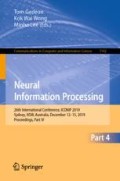Abstract
In this paper, we aim to investigate the similarities and differences of multimodal signals between Chinese and French on three emotions recognition task using deep learning. We use videos including positive, neutral and negative emotions as stimuli material. Both Chinese and French subjects wear electrode caps and eye tracking glass while doing experiments to collect electroencephalography (EEG) and eye movement data. To deal with the problem of lacking data for training deep neural networks, conditional Wasserstein generative adversarial network is adopted to generate EEG and eye movement data. The EEG and eye movement features are fused by using Deep Canonical Correlation Analysis to analyze the relationship between EEG and eye movement data. Our experimental results show that French has higher classification accuracy on beta frequency band while Chinese performs better on gamma frequency band. In addition, EEG signals and eye movement data of French participants have complementary characteristics in discriminating positive and negative emotions.
Access this chapter
Tax calculation will be finalised at checkout
Purchases are for personal use only
References
Jack, R.E., Garrod, O.G.B., Yu, H., Caldara, R., Schyns, P.G.: Facial expressions of emotion are not culturally universal. Proc. Natl. Acad. Sci. 109(19), 7241–7244 (2012)
Ekman, P., et al.: Universals and cultural differences in the judgments of facial expressions of emotion. J. Pers. Soc. Psychol. 53(4), 712–717 (1987)
Sauter, D.A., Eisner, F., Ekman, P., Scott, S.K.: Cross-cultural recognition of basic emotions through nonverbal emotional vocalizations. Proc. Natl. Acad. Sci. 107(6), 2408–2412 (2010)
Bryant, G., Barrett, H.C.: Vocal emotion recognition across disparate cultures. J. Cogn. Culture 8(1–2), 135–148 (2008)
Elfenbein, H.A., Ambady, N.: On the universality and cultural specificity of emotion recognition: a meta-analysis. Psychol. Bull. 128(2), 203 (2002)
Hutchison, A.N., Gerstein, L.H.: The impact of gender and intercultural experiences on emotion recognition. Revista De Cercetare Si Interventie Sociala 54, 125 (2016)
Zheng, W.-L., Zhu, J.-Y., Lu, B.-L.: Identifying stable patterns over time for emotion recognition from EEG. IEEE Trans. Affect. Comput. (2017)
Wu, S., Schaefer, M., Zheng, W.-L., Lu, B.-L., Yokoi, H.: Neural patterns between Chinese and Germans for EEG-based emotion recognition. In: 8th International IEEE/EMBS Conference on Neural Engineering (NER), pp. 94–97. IEEE, Shanghai (2017)
Soleymani, M., Asghari-Esfeden, S., Fu, Y., Pantic, M.: Analysis of EEG signals and facial expressions for continuous emotion detection. IEEE Trans. Affect. Comput. 7(1), 17–28 (2016)
Lea, R.G., Qualter, P., Davis, S.K., Pérez-González, J.C., Bangee, M.: Trait emotional intelligence and attentional bias for positive emotion: an eye tracking study. Pers. Individ. Differ. 128, 88–93 (2018)
Bal, E., Harden, E., Lamb, D., Van Hecke, A.V., Denver, J.W., Porges, S.W.: Emotion recognition in children with autism spectrum disorders: relations to eye gaze and autonomic state. J. Autism Dev. Disord. 40(3), 358–370 (2010)
Lu, Y., Zheng, W.L., Li, B., Lu, B.L.: Combining eye movements and EEG to enhance emotion recognition. In: IJCAI 2015, pp. 1170–1176 (2015)
Qiu, J.-L., Liu, W., Lu, B.-L.: Multi-view emotion recognition using deep canonical correlation analysis. In: Cheng, L., Leung, A.C.S., Ozawa, S. (eds.) ICONIP 2018. LNCS, vol. 11305, pp. 221–231. Springer, Cham (2018). https://doi.org/10.1007/978-3-030-04221-9_20
Wu, X., Zheng, W.-L., Lu, B.-L.: Identifying functional brain connectivity patterns for EEG-based emotion recognition. In: 9th International IEEE/EMBS Conference on Neural Engineering. IEEE, San Francisco (2019)
Luo, Y., Lu, B.-L.: EEG data augmentation for emotion recognition using a conditional wasserstein GAN. In: 40th Annual International Conference of the IEEE Engineering in Medicine and Biology Society (EMBC), pp. 2535–2538. IEEE, Honolulu (2018)
Gulrajani, I., Ahmed, F., Arjovsky, M., Dumoulin, V., Courville, A.C.: Improved training of Wasserstein GANs. In: Advances in Neural Information Processing Systems, NIPS, Long Beach, pp. 5767–5777 (2017)
Schaefer, A., Nils, F., Sanchez, X., Philippot, P.: Assessing the effectiveness of a large database of emotion-eliciting films: a new tool for emotion researchers. Cogn. Emot. 24(7), 1153–1172 (2010)
Zheng, W.-L., Lu, B.-L.: Investigating critical frequency bands and channels for EEG-based emotion recognition with deep neural networks. IEEE Trans. Auton. Ment. Dev. 7(3), 162–175 (2015)
Acknowledgements
This work was supported in part by the grants from the National Key Research and Development Program of China (Grant No. 2017YFB1002501), the National Natural Science Foundation of China (Grant No. 61673266), and the Fundamental Research Funds for the Central Universities.
Author information
Authors and Affiliations
Corresponding author
Editor information
Editors and Affiliations
Rights and permissions
Copyright information
© 2019 Springer Nature Switzerland AG
About this paper
Cite this paper
Gan, L., Liu, W., Luo, Y., Wu, X., Lu, BL. (2019). A Cross-Culture Study on Multimodal Emotion Recognition Using Deep Learning. In: Gedeon, T., Wong, K., Lee, M. (eds) Neural Information Processing. ICONIP 2019. Communications in Computer and Information Science, vol 1142. Springer, Cham. https://doi.org/10.1007/978-3-030-36808-1_73
Download citation
DOI: https://doi.org/10.1007/978-3-030-36808-1_73
Published:
Publisher Name: Springer, Cham
Print ISBN: 978-3-030-36807-4
Online ISBN: 978-3-030-36808-1
eBook Packages: Computer ScienceComputer Science (R0)

